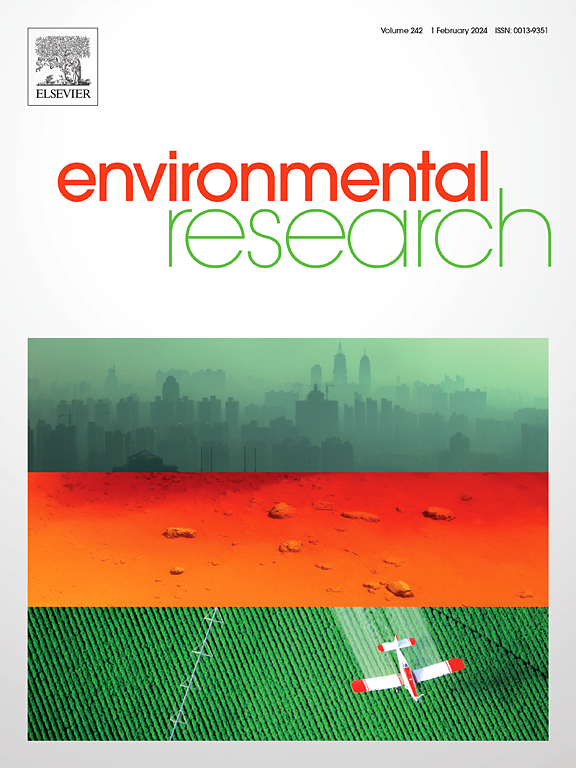Distinct co-succession of dissolved organic matter and bacterial generalists and specialists in inflow rivers of Baiyangdian Lake
IF 7.7
2区 环境科学与生态学
Q1 ENVIRONMENTAL SCIENCES
引用次数: 0
Abstract
Dissolved organic matter (DOM) significantly affects the stability of river microorganisms, but the seasonal regulatory mechanisms of generalists and specialists remain unclear. Through spectral measurement and high-throughput sequencing techniques, the structural, network, and evolutionary characteristics of generalists and specialists in Baiyangdian lake inflow rivers from 2021 to 2023 were analyzed, and the influences of environmental factors and DOM on their dynamics were quantified. Parallel factor analysis (PARAFAC) identified two protein-like components (C1+C2) and one humus-like component (C3). Among them, the protein-like components were significantly higher in urban reclaimed water (URW) than in non-urban reclaimed water (NRW), while the humus-like component was higher in summer than in winter (P < 0.001). The relative concentration of DOM was higher in summer, showing overall low humification and strong autochthonous characteristics (FI > 1.8, HIX <4). Actinobacteriota and Proteobacteria were the main components of generalists and specialists. Species replacement had a much greater impact on β-diversity than richness differences. The network structure of winter and NRW exhibited more complex topological properties, and the stability of generalist networks was lower than that of specialists. Stochastic processes dominated the community assembly process (63.73 %–93.94 %), with generalists in summer being more influenced by stochastic processes, while the opposite was true in winter. The BiSSE model indicated that specialists exhibited higher diversification potential than generalists. Path analysis showed that in summer URW, diversity and protein-like components had the greatest impact on the network stability of generalists and specialists, respectively. In NRW, humus-like component had the greatest impact on the network stability of specialists. This study clarified the mechanism by which the seasonal characteristics of DOM drive the ecological strategy differentiation of generalists and specialists in rivers, providing a theoretical basis for watershed ecological management.

白洋淀入流河流中溶解有机质与细菌多面体和专门体的明显共演替
溶解有机物(DOM)对河流微生物的稳定性有显著影响,但通性微生物和专性微生物的季节调控机制尚不清楚。通过光谱测量和高通量测序技术,分析了2021-2023年白洋淀入湖河流中通性微生物和专性微生物的结构、网络和进化特征,并量化了环境因子和DOM对其动态变化的影响。平行因子分析(PARAFAC)确定了两个蛋白质类成分(C1+C2)和一个腐殖质类成分(C3)。其中,蛋白质类成分在城市再生水中(URW)明显高于非城市再生水(NRW),而腐殖质类成分在夏季高于冬季(P < 0.001)。夏季 DOM 的相对浓度较高,总体腐殖化程度较低,具有较强的自生特征(FI > 1.8,HIX < 4)。放线菌群和变形菌群是普通菌群和特种菌群的主要组成部分。物种替换对 β 多样性的影响远大于丰富度差异。冬季和北风带的网络结构表现出更复杂的拓扑特性,通性网络的稳定性低于专性网络。随机过程在群落组装过程中占主导地位(63.73%-93.94%),夏季通类受随机过程的影响更大,而冬季则相反。BiSSE 模型表明,专科生比通科生表现出更高的多样化潜力。路径分析显示,在夏季 URW 中,多样性和类蛋白成分分别对通才和专才的网络稳定性影响最大。在北莱茵河流域,腐殖质类成分对专性植株网络稳定性的影响最大。该研究阐明了DOM的季节性特征驱动河流中通性动物和专性动物生态策略分化的机制,为流域生态管理提供了理论依据。
本文章由计算机程序翻译,如有差异,请以英文原文为准。
求助全文
约1分钟内获得全文
求助全文
来源期刊

Environmental Research
环境科学-公共卫生、环境卫生与职业卫生
CiteScore
12.60
自引率
8.40%
发文量
2480
审稿时长
4.7 months
期刊介绍:
The Environmental Research journal presents a broad range of interdisciplinary research, focused on addressing worldwide environmental concerns and featuring innovative findings. Our publication strives to explore relevant anthropogenic issues across various environmental sectors, showcasing practical applications in real-life settings.
 求助内容:
求助内容: 应助结果提醒方式:
应助结果提醒方式:


